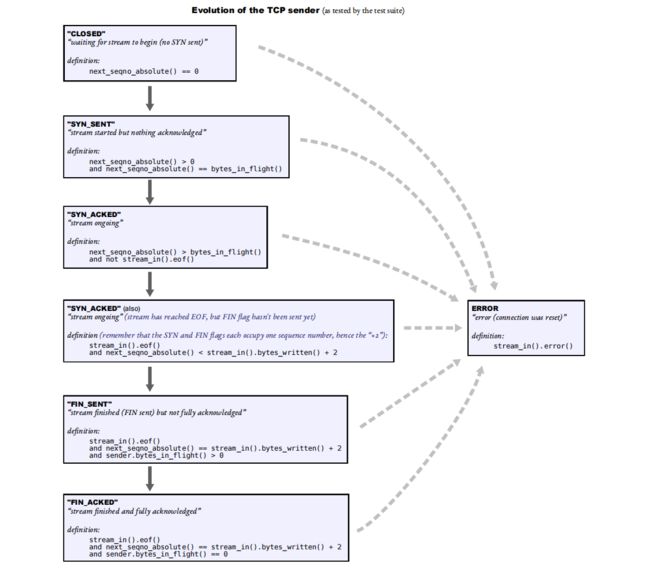CS144 计算机网络实验 lab3 笔记
CS144 计算机网络实验 lab3 笔记
介绍
本实验中,我们将会在之前实验的基础上,实现一个TCP sender ----将字节流转换成数据报并发送.
TCP协议是一个在不可靠的协议上提供可靠的,流量控制的协议。
我们在本实验中会实现一个TCP发送端,负责将发送端应用层传入的比特流转换成一系列由发出的TCP报文段,在另一端,由TCP接收端将TCP报文段转换成原始比特流(也有可能什么都不做,在从未受到syn,或者多次受到的时候),并将ack和窗口大小返回给TCP发送端
TCP接收端和发送端都负责处理一部分TCP报文段。TCP发送端写入到报文中的每部分都会被TCP接收端解析,包括:seq,SYN,FIN,内容
但是,TCP发送端只会一部分报文的内容,包括:ackno和SYN
TCP发送端有以下任务:
- 跟踪
window size,也就是处理ackno和window sizes - 尽可能的填充 ( 自己的 )
windows,直到满了或者ByteStream空了为止 - 对已经发送但没有收到
ackno的报文段 ( 未被确认的报文段) 保持跟踪 - 如果超出规定的时间,还没有收到对应的
ack,就重新发送所有已经发送,但没有收到ackno的报文段
TCP发送端是如何知道报文段丢失呢?
TCP发送端会发送一系列的报文段. 每个报文段都是来自ByteStream的子串加上位置索引seq,如果是第一个报文段,需要加上syn,最后一个需要加上fin
为了发送这些报文段,TCP发送端会对所有已发送的报文段保持跟踪,直到收到响应报文段的ack
具体实现:
- TCP发送端会定期的调用
TCPSender::tick函数,来表明时间的流逝. - TCP发送端负责监管已发出报文段,如果最早的已发出但没有收到
ack的报文段,超出了规定时间,它将会被重新发送
实现记录时间,以及计算时间
- 每隔几毫秒,TCP发送端的
TCPSender’s tick方法将被调用,它告自上次调用此方法以来已经过多少毫秒,不需要自己处理时间 - 当TCP发送端初始化的时候,将会有一个
retransmission timeout (RTO),这就是重传时间,重传时间是变化的,但是最初的超时时间都是一样的,需要调用_initial retransmission timeout - 实现一个重传定时器: 当重传时间到达时发出警告,超过重传时间关闭警告,只可以依赖
tick方法,不可以根据现实时间 - 每次一个数据报发送的时候,如果定时器没有开启,就要开启定时器
- 当确认所有数据时,停止重传计时器
- 如果调用
tick后发现定时器过期:- 重传最早的未收到
ack的包 - 如果
windows size大小不为零:- 你需要跟踪连续重传的数量,因为TCP连接需要据此判断连接是否出现问题,是否需要中断
- 将重传定时器时长加倍,这叫做
exponential backoff指数补偿,随着重传次数的增加,补偿的程度也会指数增长
- 在超过重传时间后重置重传定时器并开启
- 重传最早的未收到
- 当成功收到数据
- 设置重传时间为初始值
- 如果发送重传数据,就需要重启定时器
- 将连续重传记录的数量置零
实现TCP发送端 Implementing the TCP sender
思路
void fill_window()- TCP发送端被要求尽可能的读取
ByteStream中的数据,并且形成数据报 ( 未发送 ) - 确保每次发送的数据报的量正好等于TCP接收端窗口的大小
- 使用
TCPSegment::length in sequence space()得到seq,不要忘了SYN , FIN 也占用一个序列号,所以也占用窗口空间
- TCP发送端被要求尽可能的读取
void ack_received(const WrappingInt32 ackno, const uint16 t window size)- 得到接收端TCP窗口的左沿和大小 ,
ackno理应大于所有已发送数据报的seq
- 得到接收端TCP窗口的左沿和大小 ,
void tick( const size t ms since last tick )- 表示自从上一次发送后经过多少毫秒了.不需要我们来调用,参数的意义是距离上次调用经过了多少时间,这个不需要我们操心,我们需要实现每次调用
tick()的时候函数做什么
- 表示自从上一次发送后经过多少毫秒了.不需要我们来调用,参数的意义是距离上次调用经过了多少时间,这个不需要我们操心,我们需要实现每次调用
void send empty segment()- 生成空的数据报,只发一个
ack
- 生成空的数据报,只发一个
思路总结
void tick( const size t ms since last tick )- 表示自从上一次发送后经过多少毫秒了.不需要我们来调用,参数的意义是距离上次调用经过了多少时间,这个不需要我们操心,我们需要实现每次调用
tick()的时候函数做什么
- 表示自从上一次发送后经过多少毫秒了.不需要我们来调用,参数的意义是距离上次调用经过了多少时间,这个不需要我们操心,我们需要实现每次调用
- 我,们需要存储已发送但未被确认的报文段,进行累计确认,如果超时,只需要重传最早的报文段即可
TCPReceiver调用unwrap时的checkpoint是上一个接收到的报文段的absolute_seqno,TCPSender调用unwrap时的checkpoint是_next_seqno。retransmission timeout(RTO),具体实现是RFC6298的简化版- 重传连续的之后double ;收到ackno后重置到
_initial_RTO - 可参考RFC 6298第5小节实现_timer
- 重传连续的之后double ;收到ackno后重置到
加入成员变量
private:
bool _syn_sent = false;
bool _fin_sent = false;
uint64_t _bytes_in_flight = 0; // Number of bytes in flight 就是未被确认的字节数
uint16_t _receiver_window_size = 0; //接收方的滑动窗口
uint16_t _receiver_free_space = 0; //接收方的剩余空间
uint16_t _consecutive_retransmissions = 0; //
unsigned int _time_elapsed = 0;
bool _timer_running = false;
std::queue<TCPSegment> _segments_outstanding{}; // the segment has been sent
void send_segment(TCPSegment &seg); // send segment
bool _ack_valid(uint64_t abs_ackno);
//! our initial sequence number, the number for our SYN.
WrappingInt32 _isn;
//! outbound queue of segments that the TCPSender wants sent
std::queue<TCPSegment> _segments_out{};
//! retransmission timer for the connection
unsigned int _initial_retransmission_timeout;
//! outgoing stream of bytes that have not yet been sent
ByteStream _stream;
//! the (absolute) sequence number for the next byte to be sent
uint64_t _next_seqno{0};
unsigned int _rto = 0;
public:
函数实现
fill_window() 实现
- 如果syn未发送,发送并返回
- 如果syn未应答,返回
- 如果fin已发送,返回
- 如果 _receiver_window_size 不为 0
- 当 receiver_free_space 不为 0,尽可能地填充 payload
- 如果 _stream 已经 EOF,且 _receiver_free_space 仍不为 0,填上 FIN(fin 也会占用 _receiver_free_space)
- 如果 _receiver_free_space 还不为 0,且 _stream 还有内容,回到步骤 1 继续填充
- 如果 _receiver_window_size 为 0,则需要发送零窗口探测报文
- 如果 _receiver_free_space 为 0
- 如果 _stream 已经 EOF,发送仅携带 FIN 的报文
- 如果 _stream 还有内容,发送仅携带一位数据的报文
- 如果 _receiver_free_space 为 0
send_segment()实现
- 发送
seq,不要忘记isn - 记录接收方窗口大小,如果
syn true,减去发送包的大小 - 如果计时器未开启,开启计时器
其他的都很好理解,看一下代码就能懂
总体来说,有点小复杂,总有一些地方不明了,最后借鉴了一位博主的实现成功完成
#include "tcp_sender.hh"
#include "tcp_config.hh"
#include 

